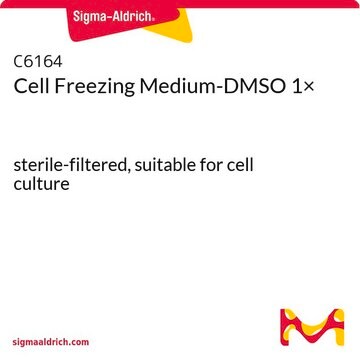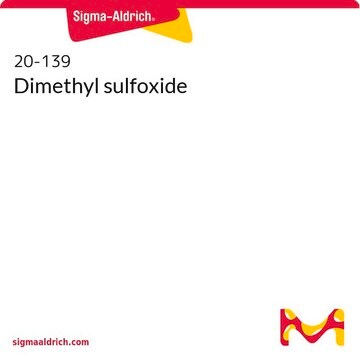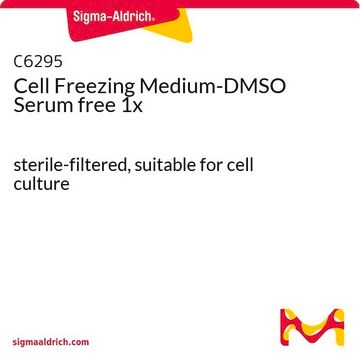D8418
Dimethyl sulfoxide
for molecular biology
Synonym(s):
Methyl Sulfoxide, Methylsulfinylmethane, Molecular Biology Grade DMSO, DMSO
About This Item
PCR: suitable
transfection: suitable
Recommended Products
grade
for molecular biology
Quality Level
vapor density
2.7 (vs air)
vapor pressure
0.42 mmHg ( 20 °C)
product line
BioReagent
assay
≥99.9%
form
liquid
autoignition temp.
573 °F
shelf life
Recommended retest period - 2 years
expl. lim.
42 %, 63 °F
technique(s)
DNA sequencing: suitable
PCR: suitable
transfection: suitable
impurities
≤0.001 meq/g Titratable acid
≤0.1% water (Karl Fischer)
color
colorless
refractive index
n20/D 1.479 (lit.)
bp
189 °C (lit.)
mp
16-19 °C (lit.)
solubility
H2O: miscible (completely)
density
1.10 g/mL (lit.)
absorption
passes test
suitability
suitable for molecular biology
foreign activity
DNase and RNase, none detected
storage temp.
room temp
SMILES string
CS(C)=O
InChI
1S/C2H6OS/c1-4(2)3/h1-2H3
InChI key
IAZDPXIOMUYVGZ-UHFFFAOYSA-N
Looking for similar products? Visit Product Comparison Guide
General description
- Suitable for Molecular Applications
- Nuclease-Free DMSO
- DNase-Free, RNase-Free, Protease-Free, Phosphatase-Free
- Molecular Biology Grade DMSO
Dimethyl sulfoxide (DMSO) is a highly polar organic reagent that has exceptional solvent properties for organic and inorganic chemicals.
This product is designated as Molecular Biology grade and is suitable for molecular biology applications. It has been analyzed for the presence of nucleases and proteases.
Application
- polymerase chain reaction (PCR)
- amplification of cDNA libraries
- DNA sequencing
- column-loading buffers for poly(A)+ RNA selection
- buffers for the transformation of competent E. coli
- transfection protocols.
Dimethyl sulfoxide has been used-
- as an oligonucleotide solvent in array spotting[1]
- as a solvent during miRNA microarray analysis and quantitative real-time PCR (qRT-PCR)
- for cell lysis during MTT (3-(4,5-dimethylthiazol-2-yl)-2,5-diphenyltetrazolium bromide) assay
- for the preparation of the stock solution during MMP (mitochondrial membrane potential)cytofluorimetric assessment
- in the storage of human and animal cell lines and bacteriophage λ as a cryoprotective agent.
Features and Benefits
Caution
also commonly purchased with this product
related product
suggested gloves for splash protection
Storage Class
10 - Combustible liquids
wgk_germany
WGK 1
flash_point_f
188.6 °F - closed cup
flash_point_c
87 °C - closed cup
ppe
Eyeshields, Gloves, type ABEK (EN14387) respirator filter
Choose from one of the most recent versions:
Certificates of Analysis (COA)
Don't see the Right Version?
If you require a particular version, you can look up a specific certificate by the Lot or Batch number.
Already Own This Product?
Find documentation for the products that you have recently purchased in the Document Library.
Customers Also Viewed
Articles
Transformation introduces exogenous DNA into cells, a fundamental genetic modification process demonstrated in Streptococcus pneumoniae.
SeqPlex™-I WTA kit amplifies RNA for NGS, enabling genomic studies from limited samples.
Protocols
Yeasts are considered model systems for eukaryotic studies as they exhibit fast growth and have dispersed cells.
Learn how to cultivate similar-sized iPSC-derived colon organoids using Millicell® Microwell plates and perform a forskolin-induced swelling assay.
A step-by-step protocol for released N-linked glycan analysis of the monoclonal antibody adalimumab, based on UHPLC-FLR-MS and procainamide labeling.
Related Content
KOD One™ PCR Master Mix overview for ultra-fast PCR with high specificity, fidelity, and yield
Our team of scientists has experience in all areas of research including Life Science, Material Science, Chemical Synthesis, Chromatography, Analytical and many others.
Contact Technical Service



